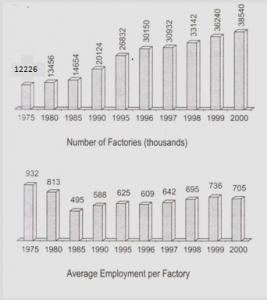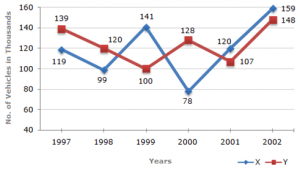DIRECTIONS (1-5) :Study the information given and answer the following questions.

1)Between 1995 and 2000, in which year has the average employment per factory shown an increment compared to previous year, but decreased in the next year?
1) 1996
2) 1997
3) 1998
4) 1999
5) None of these
2)If in 1996, 20,100 factories had 659 employments on an average, the remaining factories had an average employment of?
1) 559
2) 509
3) 584
4) 534
5) None of these
3)The total employment in 1999 is how many times to that in 1996?
1) 1.45
2) 1.48
3) 1.6
4) 1.42
5) None of these
4)In which of the following five-year period, number of factories has shown maximum increase?
1) 1980-85
2) 1985-90
3) 1990-95
4) 1995-00
5) None of these
5)Among the given period, in how many years has the trend of the average employment per factory not changed with respect to the previous year’s change?
1) Two
2) Three
3) Four
4) Can’t be determined
5) None of these
Directions (6 – 10): Study the following line graph and answer the questions based on it.
Number of Vehicles Manufactured by Two companies over the Years (Number in Thousands)

6)What is the difference between the number of vehicles manufactured by Company Y in 2000 and 2001?
1) 50, 000
2) 42, 000
3) 33, 000
4) 21, 000
5) None of these
7)What is the difference between the total productions of the two Companies in the given years ?
(1) 19, 000
(2) 22, 000
(3) 26, 000
(4) 28, 000
(5) None of these
8)What is the average numbers of vehicles manufactured by Company X over the given period? (Rounded off to nearest integer)
1) 1, 19, 333
2) 1, 13, 666
3) 1, 12, 778
4) 1, 11, 223
5) None of these
9)In which of the following years, the difference between the productions of Companies X and Y was the maximum among the given years?
1) 1997
2) 1998
3) 1999
4) 2000
5) None of these
10)The production of Company Y in 2000 was approximately what percent of the production of Company X in the same year?
1) 173
2) 164
3) 132
4) 97
5) None of these
















